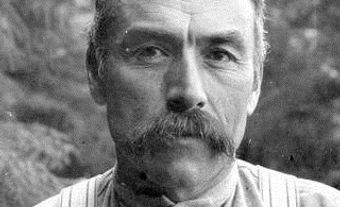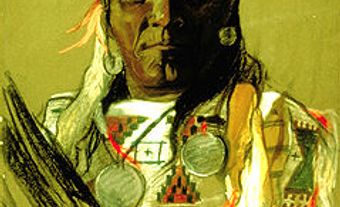He had little formal education and was encouraged to learn from his Shoshone-Cree elders. Moving to an Alberta ranch in 1964, he began the poems and drawings for There Is My People Sleeping (1969). Stump promoted traditional Indigenous values and sought to help young Indigenous people gain pride in their heritage while coping with the modern world. He was the Indigenous art program coordinator at the Saskatchewan Indian Cultural College 1972-74. As a painter he was influenced by the traditional art of the Plains Indigenous people; as well he was interested in searching for what he called his Aztecan roots, since the Shoshone tribe is related by language to the Uto-Aztecan family. His paintings dealt with social-realist themes of Indigenous religion and history and their modern urban struggles.
-
- MLA 8TH EDITION
- McMaster, Gerald R.. "Sarain Stump". The Canadian Encyclopedia, 16 December 2013, Historica Canada. www.thecanadianencyclopedia.ca/en/article/sarain-stump. Accessed 23 December 2024.
- Copy
-
- APA 6TH EDITION
- McMaster, G. (2013). Sarain Stump. In The Canadian Encyclopedia. Retrieved from https://www.thecanadianencyclopedia.ca/en/article/sarain-stump
- Copy
-
- CHICAGO 17TH EDITION
- McMaster, Gerald R.. "Sarain Stump." The Canadian Encyclopedia. Historica Canada. Article published January 30, 2008; Last Edited December 16, 2013.
- Copy
-
- TURABIAN 8TH EDITION
- The Canadian Encyclopedia, s.v. "Sarain Stump," by Gerald R. McMaster, Accessed December 23, 2024, https://www.thecanadianencyclopedia.ca/en/article/sarain-stump
- Copy
Thank you for your submission
Our team will be reviewing your submission
and get back to you with any further questions.
Thanks for contributing to The Canadian Encyclopedia.
CloseArticle
Sarain Stump
Article by Gerald R. McMaster
Published Online January 30, 2008
Last Edited December 16, 2013
Sarain Stump, Indigenous name Sock-a-jaw-wu, meaning "the one who pulls the boat," painter, poet (b at Fremont, Wyo 1945; d by drowning near Mexico City, Mexico 20 Dec 1974).

 Share on Facebook
Share on Facebook Share on X
Share on X Share by Email
Share by Email Share on Google Classroom
Share on Google Classroom


